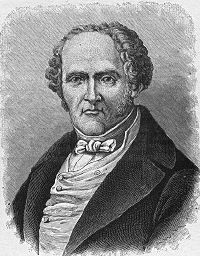Charles Fourier
This article is about the French utopian socialist philosopher. For other famous Fouriers, see Fourier.
François Marie Charles Fourier (April 7, 1772 - October 10, 1837) was a French utopian socialist and philosopher. Fourier coined the word féminisme in 1837; as early as 1808, he had argued that the extension of women's rights was the general principle of all social progress. Fourier inspired the founding of the communist community called La Reunion near present-day Dallas, Texas as well as several other communities within the United States of America, such as North American Phalanx.
Biography
Fourier was born in 1772. He moved from his native Besançon to Lyon, the second largest city in France. As a travelling salesman and correspondence clerk, his research and thought was time-limited: he complained of "serving the knavery of merchants" and the stupefication of "deceitful and degrading duties". A modest legacy set him up as a writer. He had three main sources for his thought: people he had met as a travelling salesman, newspapers, and introspection. His first book was published in 1808.
Latterly he lived in Paris, where he died in 1837.
Ideas
Fourier declared that concern and cooperation were the secrets of social success. He believed that a society that cooperated would see an immense improvement in their productivity levels. Workers would be recompensed for their labors according to their contribution. Fourier saw such cooperation occurring in communities he called "phalanxes". Phalanxes were based around structures called "grand hotels," (or Phalanstère). These buildings were four level apartment complexes where the richest had the uppermost apartments and the poorest enjoyed a ground floor residence. Wealth was determined by one's job; jobs were assigned based on the interests and desires of the individual. There were incentives: jobs people might not enjoy doing would receive higher pay.
He believed that there were twelve common passions which resulted in 810 types of character, so the ideal phalanx would have exactly 1620 people. One day there would be six million of these, loosely ruled by a world "omniarch", or (later) a World Congress of Phalanxes. He had a touching concern for the sexually rejected - jilted suitors would be led away by a corps of "fairies" who would soon cure them of their lovesickness, and visitors could consult the card-index of personality types for suitable partners for casual sex. He also defended homosexuality as a personal preference for some people.
Influence
The influence of Fourier's ideas in French politics was carried forward into the 1848 Revolution and the Paris Commune by followers such as Victor Considérant.
Fourier's ideas also took root in America starting several branches of what is often called a cult. Fourier's followers started phalanxes throughout America and were responsible for one of the more famous ones, Utopia, Ohio.
In the middle of the 20th century, Fourier's influence began to rise again among writers reappraising socialist ideas outside the Marxist mainstream. After the Surrealists had broken with the French Communist Party, André Breton returned to Fourier, writing Ode à Charles Fourier in 1947. In 1969, the Situationists quoted and adapted Fourier's Avis aux civilisés relativement à la prochaine métamorphose sociale in their text Avis aux civilisés relativement à l'autogestion généralisée.
Contemporary influence
Fourier's work has significantly influenced the writings of Gustav Wyneken, Guy Davenport, Hakim Bey, and Paul Goodman and probably influenced the Italian boss Adriano Olivetti in the management of his electronic company.
In Whit Stillman's film Metropolitan, social idealist Tom is described as a Fourierist, and debates the success of social experiment Brook Farm with another of the characters.
Fourier's works
- Fourier, Charles. Théorie des quatre mouvements et des destinees generales (Theory of the four movements and the general destinies), appeared anonymously in Lyon in 1808.
- Fourier, Charles. Oeuvres complètes de Charles Fourier. 12 vols. Paris: Anthropos, 1966-1968.
- Jones, Gareth Stedman, and Ian Patterson, eds. Fourier: The Theory of the Four Movements. Cambridge Texts in the History of Political Thought. Cambridge: Cambridge UP, 1996.
- Fourier, Charles. Design for Utopia: Selected Writings. Studies in the Libertarian and Utopian Tradition. New York: Schocken, 1971. ISBN 0-8052-0303-6
ReferencesISBN links support NWE through referral fees
{{#invoke:Message box|ambox}}
On Fourier and his works
- Beecher, Jonathan (1986). Charles Fourier: the visionary and his world. Berkeley: University of California Press. ISBN 0-520-05600-0.
- Burleigh, Michael (2005). Earthly powers : the clash of religion and politics in Europe from the French Revolution to the Great War. New York: HarperCollins Publishers. ISBN 0-06-058093-3.
On Fourierism and Fourier's posthumous influences
- Barthes, Roland Sade Fourier Loyola. Paris: Seuil, 1971.
- Brock, William H. Phalanx on a Hill: Responses to Fourierism in the Transcendentalist Circle. Diss., Loyola U Chicago, 1996.
- Buber, Martin (1996). Paths in Utopia. Syracuse, N.Y.: Syracuse University Press. ISBN 0-8156-0421-1.
- Davis, Philip G. (1998). Goddess unmasked : the rise of neopagan feminist spirituality. Dallas, Tex.: Spence Pub.. ISBN 0-9653208-9-8.
- Desroche, Henri. La Société festive. Du fouriérisme écrit au fouriérismes pratiqués. Paris: Seuil, 1975.
- Engels, Frederick. Anti-Dühring. 25:1-309. Marx, Karl, and Frederick Engels. Karl Marx, Frederick Engels: Collected Works [MECW]. 46 vols. to date. Moscow: Progress, 1975.
- Guarneri, Carl J. (1991). The utopian alternative : Fourierism in nineteenth-century America. Ithaca, N.Y.: Cornell University Press. ISBN 0-8014-2467-4.
- Heider, Ulrike (1994). Anarchism : left, right, and green. San Francisco: City Lights Books. ISBN 0-87286-289-5.
- Kolakowski, Leszek (1978). Main Currents of Marxism: The Founders. Oxford: Oxford University Press. ISBN 0198245475.
See also
- Alphadelphia Association
- Brook Farm
- La Reunion (Dallas)
- North American Phalanx
External links
| Schools of economics |
| Pre-modern |
|---|
| Early Modern |
| Modern |
|
Classical Economics |
| Twentieth-century |
|
Institutional economics · Stockholm school |
bs:Charles Fourier cs:Charles Fourier da:Charles Fourier de:Charles Fourier et:Charles Fourier el:Σαρλ Φουριέ es:Charles Fourier eo:Charles Fourier fr:Charles Fourier gl:Charles Fourier hr:Charles Fourier io:Charles Fourier it:Charles Fourier he:שארל פורייה hu:Charles Fourier nl:Charles Fourier no:Charles Fournier oc:Charles Fourier ug:ﻓﯘﺭﻳﯥ pl:Charles Fourier pt:Charles Fourier ro:Charles Fourier ru:Фурье, Шарль sk:François Marie Charles Fourier fi:Charles Fourier sv:Charles Fourier zh:夏尔·傅立叶
Credits
New World Encyclopedia writers and editors rewrote and completed the Wikipedia article in accordance with New World Encyclopedia standards. This article abides by terms of the Creative Commons CC-by-sa 3.0 License (CC-by-sa), which may be used and disseminated with proper attribution. Credit is due under the terms of this license that can reference both the New World Encyclopedia contributors and the selfless volunteer contributors of the Wikimedia Foundation. To cite this article click here for a list of acceptable citing formats.The history of earlier contributions by wikipedians is accessible to researchers here:
The history of this article since it was imported to New World Encyclopedia:
Note: Some restrictions may apply to use of individual images which are separately licensed.

